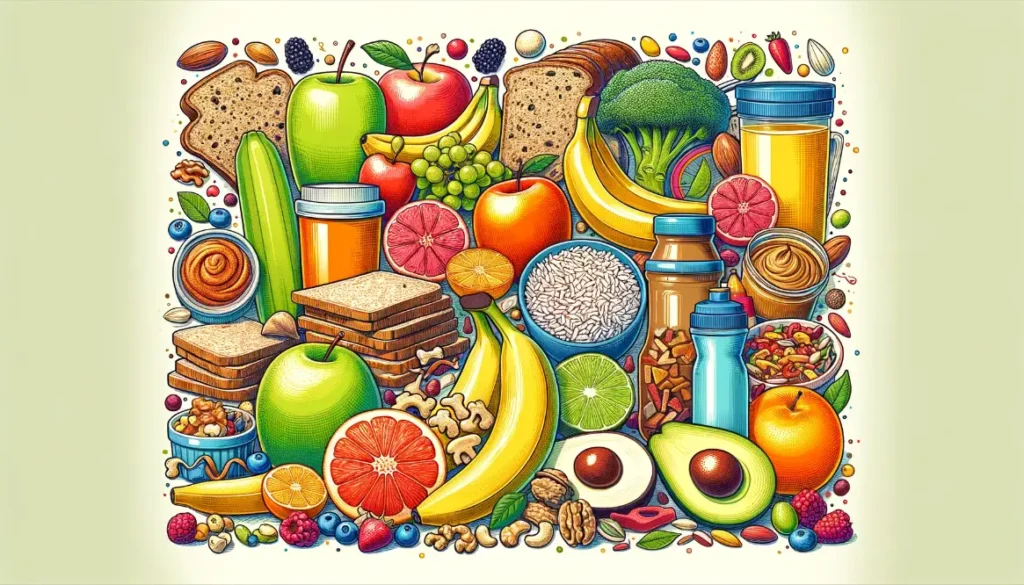
Going on long bike rides requires planning and preparation to keep you fueled and performing at your best. Eating well can make the difference between successfully covering the distance and bonking halfway through your ride. This article will provide tips on the optimal foods to eat before, during and after a long bike ride.
Introduction to Long Bike Rides
Long bike rides are generally considered to be anything over 50 miles or 3 hours of cycling. Rides of this duration place considerable physical and nutritional demands on the body.
Duration and Distance
You’ll be exerting yourself for extended periods of time, so having adequate fuel stores in the form of muscle and liver glycogen is essential. It’s also important to keep replenishing nutrients throughout the ride. Successfully preparing your body with the right nutrition can help you maintain optimal energy levels.
Preparation is Key
Proper planning and preparation helps ensure you get the most enjoyment out of your long ride.
Check the Route
Study the route in advance so you know what to expect – where the big climbs are, potential food/water stops and bail-out points if needed. Share your route with someone.
Pack Spare Tubes and Tools
There’s nothing worse than mechanical issues derailing your ride. Carry essential spare tubes, a pump (or CO2 inflator) and any tools you may need for basic repairs.
Tune Up Your Bike
It’s wise to give your bike a full inspection and tune up before a big ride – clean the drivetrain, brake pads, cables, check bolt tightness and ensure shifters are indexed properly. This prevents any unwelcome surprises!
Importance of Nutrition
Here is a table summarizing some of the key information on what to eat for long bike rides:
| When | What to Eat | Why |
|---|---|---|
| 1-4 hours before | Slow-release carbs like oatmeal, whole-grain toast, pasta | Maximizes glycogen stores for fuel |
| Protein like eggs, yogurt, nut butter | Helps maintain and build muscle | |
| During (every 30-60 mins) | Fast carbs – gels, blocks, chews | Rapidly absorbed glucose |
| Dried fruit, bananas, rice cakes | Replenishes spent muscle glycogen | |
| After | Fast-absorbing carbs – chocolate milk, juice | Rapidly restores glycogen |
| Protein – yogurt, milk, eggs, meat | Muscle repair and growth | |
| Anti-inflammatories – berries, leafy greens | Reduces muscle soreness | |
| Always | Electrolytes through sports drinks, coconut water | Maintains hydration |
| Ample fluids (500-1000ml/hr) | Prevents dehydration |
The key messages are:
- Consume slow-release carbs before and easily digestible carbs during rides
- Protein feeds long term muscle repair and growth
- Hydrate constantly with electrolytes
- Anti-inflammatory foods aid recovery
Consuming the right nutrition is vital for maintaining energy, preventing fatigue and aiding your recovery.
Maintains Energy Levels
Eating correctly provides a steady supply of fuel for your muscles in the form of glycogen. This keeps your power and performance consistent.
Prevents Fatigue and “Bonking”
Run low on muscle glycogen and you’ll “bonk” – suddenly feeling fatigued as you rapidly deplete energy stores. Proper nutrition prevents this.
Aids Muscle Recovery
The right nutrients delivered soon after your ride help replenish depleted glucose/glycogen levels and assist in muscle repair and recovery.
Hydration Tips
Staying well hydrated is also key to avoiding fatigue and muscle cramps.
Sip Frequently From Your Water Bottle
Little and often is best – gulping large volumes can cause stomach upset. Aim for a bottle per hour.
Electrolyte Drinks
These help replace essential sodium, potassium and magnesium lost in sweat. This aids hydration and muscle function.
Avoid Alcohol
It acts as a diuretic, causing dehydration. Leave the post-ride beers until later!
Carbohydrates – The Rider’s Fuel

Carbs are your high-octane fuel, powering your efforts. Time carbohydrate intake correctly.
Complex Carbs – Wholegrains, Bread, Rice
Opt for slow-releasing complex carbs in the hours leading up to your ride to fully stock glycogen.
Simple Carbs – Fruits, Gels, Chews, Bars
Rapidly absorbed simple carbs during your ride quickly deliver glucose to working muscles.
Protein – For Muscle Repair
Protein performs a different role to carbs. It aids long term muscle repair rather than immediate fuel.
Nuts, Peanut Butter, Jerky, Dairy
These protein-rich foods paired with carbs can promote sustained energy and help rebuild damaged muscle fibers.
Healthy Fats – Sustained Energy
Fats fuel your efforts over longer durations. They also help your body absorb fat-soluble vitamins.
Avocados, Nut Butters, Seeds, Oily Fish
Foods containing beneficial unsaturated fats provide fatty acids that can be used for fuel and aid vitamin absorption.
Vitamins and Minerals
B vitamins, vitamin C, iron and zinc all support energy production and immune function.
Vitamin C
This antioxidant vitamin aids tissue repair and recovery post-ride.
B Vitamins
These help convert food into cellular energy, keeping muscles powered.
Iron
Vital for oxygen transport in the blood to working muscles. Low iron causes fatigue.
Zinc
This mineral supports immune function, aiding rapid recovery.
Anti-Inflammatory Foods
Long rides cause inflammation from muscle damage. Anti-inflammatory nutrients reduce this.
Berries, Leafy Greens, Fatty Fish
Foods high in antioxidants like anthocyanins or omega-3 fats have anti-inflammatory effects, speeding recovery.
Foods to Avoid
Some foods may cause stomach upset or digestive issues.
Excess Fat, Fiber, Protein or Sugar
These can result in nausea, cramps or gastric distress while riding. Stick to easily digestible carbs.
Meal Timing
When you eat is as important as what you eat when fueling long rides.
Eat Carbs and Protein 1-4 Hours Pre-Ride
Consuming slow-release carbs and a little protein before a ride fully stocks your glycogen levels.
Small Snacks Every Hour When Riding
Top up energy with simple carbs every 60 minutes. This maintains blood glucose and replenishes spent muscle fuel.
Portable Nutrition Tips
It’s essential to keep eating while pedaling. These foods are easily carried:
Energy Bars, Gels and Chews
These compact sources of simple sugars make consuming carbs on the bike easy. Chew or ingest every hour.
Jerky and Dried Fruit
Salty jerky provides protein and sodium. Dried fruits offer antioxidants and natural sugars.
Make Your Own Ride Food
Homemade snacks let you control ingredients. Try these energy-packed recipes:
Homemade Energy Balls and Bars
Make tasty nut and fruit bars using simple ingredients like oats, nuts, dried fruit, nut butters, seeds and honey.
Shopping List for Ride Day

Stock up on these easily packable calorie and nutrient-dense foods:
- Wholegrain bread/bagels, rice cakes, oatmeal
- Bananas, oranges, grapes, apples, strawberries
- Nut butter, jam, honey
- Boiled eggs, jerky
- Salami, cheese slices
- Avocado
- Trail mix, nuts, seeds
- Sports drinks, coconut water
- Energy gels, bars, blocks
Pack Your Bike Bag
Use an insulated bag and ice packs to keep foods fresh and cool:
Insulated Bag
A small insulated backpack style bag is ideal for carrying perishable nutrition.
Ice Packs
Freeze gel packs or bottles of water overnight. These help keep foods cool for hours.
Cutlery
Pack a knife, spoon and napkins so you can eat real food, not just packaged gels and bars.
Special Diets
You can fuel long rides following vegan, vegetarian, gluten-free or keto diets:
Vegan
Focus on nuts, seeds, nut butters, fruits, vegetables, whole grains and plant-based proteins.
Vegetarian
As above but also include eggs and dairy products like cheese for protein.
Gluten-Free
Emphasize rice, potatoes, sweet potatoes, fruits and naturally gluten-free whole foods.
See also: Can we do Cycling after Dinner? Pros and Cons Explained
Keto
Rely more on healthy fats like nut butters, coconut, avocado, cheese, eggs and oils paired with low carb veggies.
Staying Hydrated
Dehydration ruins rides. Sip regularly and replace electrolyte losses:
Sip Little and Often
Drink a few gulps every 15-20 minutes rather than large amounts sporadically which can cause guts issues.
Electrolyte Replacement Drinks
Formulated sports beverages contain key electrolytes like sodium and potassium lost through sweat.
GI Issues – Prevention and Relief
Stomach problems are undesirable. Avoid foods that may cause distress.
Avoid Problematic Foods
Eliminate hard-to-digest fare with excess fat, protein or fiber which could cause bloating, cramps or nausea when riding.
Ginger, Mint or Fennel
Natural anti-inflammatories like ginger, mint or fennel tea can calm stomach issues. Fennel seeds also relieve bloating.
Recovery Nutrition
Optimize recovery from long efforts with targeted nutrition:
Rehydrate
First priority is to replace fluid and electrolyte losses from heavy sweating.
Replenish Glycogen
Consuming carbohydrates soon after rides restocks depleted glucose and glycogen energy stores.
Repair Muscles
Include protein in recovery meals and snacks to provide amino acids that aid rebuilding damaged muscle fibers.
Beyond Physical Needs
Don’t become so obsessed with food that you fail to enjoy the journey:
Enjoy the Views and Company
While essential, remember nutrition is just one part of long rides. Absorb the beautiful scenery and social experience.
Safety First
Never compromise safety in pursuit of performance goals:
Obey Traffic Laws
Always ride predictably and respectfully on public roads.
Helmet and Bright Clothing
Maximize visibility to others and always wear a properly fitted helmet.
FAQs
Below are answers to common questions about fueling long bike rides:
Q: What is the best food to eat before a long bike ride?
A: Eat a carbohydrate-rich meal 1-4 hours prior such as oatmeal, whole-grain toast or fruit along with protein like eggs, nut butter or Greek yogurt. Stay adequately fueled and hydrated the days leading up too.
Q: What should I be eating every hour on a long ride? A: About 30-60 grams of easily digestible carbs every hour is optimal. Good options include energy gels, chews, bars, dried fruit, bananas, or rice cakes with honey or nut butter spread. Pair with electrolytes.
Q: How much water should I drink per hour?
A: Around 500-1000ml per hour is needed depending on rider size, effort, temperature and sweat rate. Sip small amounts frequently rather than gulping large volumes sporadically.
Q: What recovery foods promote muscle repair?
A: Chocolate milk, Greek yogurt, eggs, lean meats, tofu and spinach all provide protein to rebuild damaged muscle fibers. Pair with anti-inflammatory carbs from fruit, juice or rice.
Q: How can I avoid stomach issues when cycling? Avoid overly fatty, fibrous or protein-dense foods. Stick to easily digested carbs. Prevent dehydration and supplementing with probiotics may help.
Q: Should I eat energy gels and bars or real food? A mix is best! Gels and bars make on-bike fueling convenient but can be hard to stomach in excess. Real food like nut butter sandwiches, jerky or trail mix is great too.
Conclusion and Final Tips
Fueling properly makes completing long rides infinitely more enjoyable. Follow these nutritional guidelines to stay energized and healthy on your cycling adventures. Test various on-bike foods during training to discover what your body best tolerates and don’t neglect staying hydrated. Most importantly, take time to relish the views and company. Safe riding!






